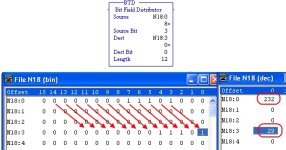I am new to plcs. I am just wondering how data is read from the encoder for controllogix AB PLCS. Also, can some explain about Bitfield distribute instruction. Rslogix help instrction didnt help me much as i still didnt get it.Also,do we use same process for both absolute and incremental encoders.One last question suppose we replace the encoder with a new one do we have to reconfigure it or is it like plug and play. Looking forward for good replies. Thanks
What instruction to use to read data from encoder?
- Thread starter bornwild
- Start date
Similar Topics
Hi All. I can write an N7 value to a modbus register in an Automation Direct Servo but I can't read a holding register to an N7 address. I've...
Lately, I've been using Modbus for reading sensor values in process programming. I haven't used Modbus much, so I spent some time looking at...
Hello,
I have a radio telemetry system that has an RS-232 interface that "understands" the DF1 protocol.
In one place I still have a Compact...
I programmed a couple of MSG instruction for a PLC5/80E to write and read data to a SLC 5/05 thru an Ethernet network on non-continuous mode. It...
All,
We are developing MSG instructions with ControlLogix; this controller is the master data collector for the plant.
However there are some...





